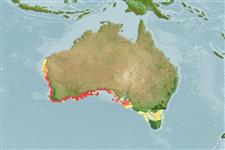Teleostei (teleosts) >
Gobiesociformes (Clingfishes) >
Gobiesocidae (Clingfishes and singleslits) > Cheilobranchinae
Etymology: Alabes: Greek, alabes, oy = a fish from the Nile, dealing with lampreys (Ref. 45335); elongata: Named for its elongate body.
Environment: milieu / climate zone / depth range / distribution range
Ecology
Marine; demersal; depth range 0 - 15 m (Ref. 56640). Subtropical
Eastern Indian Ocean: Western Australia.
Size / Weight / Age
Maturity: Lm ? range ? - ? cm
Max length : 9.2 cm SL male/unsexed; (Ref. 56640)
Short description
Identification keys | Morphology | Morphometrics
Vertebrae: 74 - 78. Diagnosis: Pelvic fins present. Gill slit large. Postocular pore 1; anterior nasal pore 1; posterior nasal and lacrymal pores absent. Vertebrae total 74-78, precaudal 22; last epineural on 28th vertebra. Caudal rays 6-9. Dorsal origin posterior to the anus. Body not transparent. This species differs from it congeners by a combination of its elongate but robust body (depth 12.5-14.9 in SL), large gill slit (2.9-4.4 in HL), prominent rudimentary pelvic fin with obvious fin rays, single postocular pore on each side of head, and unique color pattern. While it is most similar to A. dorsalis, differing in its more elongate body (depth usually greater than 12 times in SL versus 11 or less) and different coloration (lacks the dark circular blotches on midside of body that characterize the adult male of A. dorsalis) (Ref. 56640).
Body shape (shape guide): eel-like; Cross section: compressed.
Inhabits reef and weed areas from the intertidal to depths of 15 meters. It has been found in both seagrass beds as well as on rocky reefs (Ref. 56640).
Life cycle and mating behavior
Maturity | Reproduction | Spawning | Eggs | Fecundity | Larvae
Hutchins, J.B. and S. Morrison, 2004. Five new species of the genus Alabes (Gobiesocidae: Cheilobranchinae). Rec. Australian Mus. 56:147-158. (Ref. 56640)
IUCN Red List Status (Ref. 130435: Version 2025-1)
Threat to humans
Harmless
Human uses
Tools
Special reports
Download XML
Internet sources
Estimates based on models
Preferred temperature (Ref.
123201): 16.8 - 21.2, mean 18 °C (based on 101 cells).
Phylogenetic diversity index (Ref.
82804): PD
50 = 0.5005 [Uniqueness, from 0.5 = low to 2.0 = high].
Bayesian length-weight: a=0.00102 (0.00046 - 0.00225), b=3.06 (2.88 - 3.24), in cm total length, based on all LWR estimates for this body shape (Ref.
93245).
Trophic level (Ref.
69278): 3.4 ±0.3 se; based on size and trophs of closest relatives
Resilience (Ref.
120179): Medium, minimum population doubling time 1.4 - 4.4 years (Preliminary K or Fecundity.).
Fishing Vulnerability (Ref.
59153): Low vulnerability (10 of 100).
🛈
